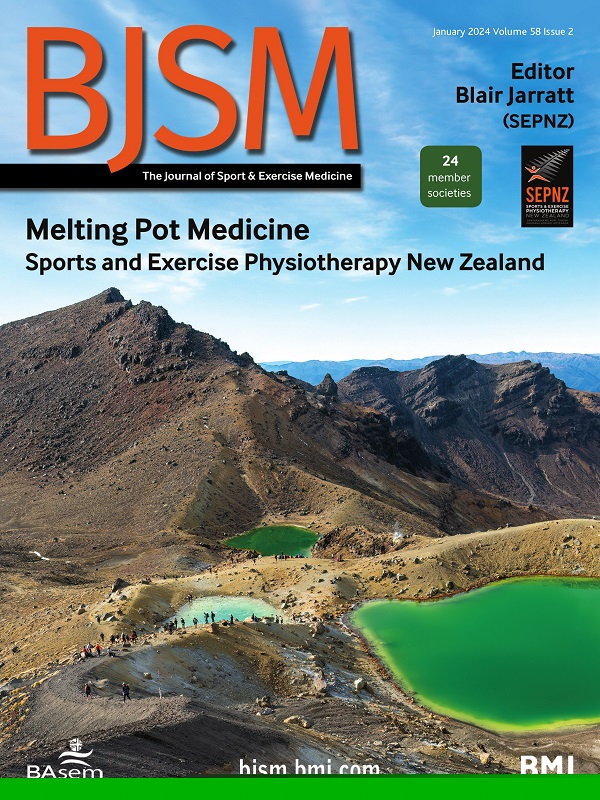Recommendations for use of extracorporeal shockwave therapy in sports medicine: an international modified Delphi study
IF 11.6
1区 医学
Q1 SPORT SCIENCES
引用次数: 0
Abstract
Objectives While extracorporeal shockwave therapy (ESWT) may be an efficacious adjunctive treatment option for musculoskeletal injuries, current research is limited by significant heterogeneity within treatment protocols. This study aims to establish international expert consensus recommendations on ESWT terminology, parameters, procedural considerations, contraindications and side effects in the application of ESWT to sports injuries. Methods A systematic literature search was performed on the use of ESWT for musculoskeletal and sports medicine injuries to identify potential panellists, followed by the development of a steering committee-led questionnaire. A three-stage, modified Delphi questionnaire was provided to a panel of 41 international clinical and research experts across 13 countries. Panellists had the opportunity to suggest edits to existing statements or recommend additional statements in Round 1. Consensus was defined as≥75% agreement. Results All 41 panellists completed Rounds 1, 2 and 3. Consensus was reached on 69/118 statements (58.5%), including recommendations on terminology and fundamental concepts, indications for use, procedural aspects for tendinopathy and bone pathologies, treatment correlations with imaging, periprocedural and postprocedural considerations, absolute and relative contraindications and potential side effects. Of the 49 statements that did not reach consensus, 17/49 (34.7%) were related to procedural aspects of bone pathology. Conclusion This international panel presents recommendations on ESWT terminology, indications and treatment considerations to guide ESWT use and decision-making by sports medicine clinicians. While our panel supported the use of ESWT in the treatment of bone pathologies, certain procedural aspects of ESWT specific to these injuries did not reach consensus and require further investigation. All data relevant to the study are included in the article or uploaded as supplementary information. Not applicable.运动医学中使用体外冲击波疗法的建议:一项国际修正德尔菲研究
虽然体外冲击波治疗(ESWT)可能是一种有效的肌肉骨骼损伤辅助治疗选择,但目前的研究受到治疗方案显著异质性的限制。本研究旨在建立ESWT在运动损伤中应用的术语、参数、程序注意事项、禁忌症和副作用的国际专家共识建议。方法对ESWT在肌肉骨骼和运动医学损伤中的应用进行了系统的文献检索,以确定潜在的小组成员,随后制定了指导委员会主导的问卷调查。由13个国家的41位国际临床和研究专家组成的小组收到了一份经过三阶段修改的德尔菲问卷。小组成员有机会对第一轮的现有陈述提出编辑建议或推荐补充陈述。一致定义为≥75%的同意。结果41名小组成员均完成了第1、2、3轮。69/118项声明达成了共识(58.5%),包括术语和基本概念的建议,使用适应症,肌腱病变和骨骼病变的程序方面,治疗与影像学的相关性,术中和术后注意事项,绝对和相对禁忌症以及潜在的副作用。在未达成一致的49例陈述中,17/49(34.7%)与骨病理的程序性方面有关。这个国际小组提出了关于ESWT术语、适应症和治疗注意事项的建议,以指导运动医学临床医生使用ESWT和决策。虽然我们的小组支持使用ESWT治疗骨病变,但ESWT特定于这些损伤的某些程序方面尚未达成共识,需要进一步研究。所有与研究相关的数据都包含在文章中或作为补充信息上传。不适用。
本文章由计算机程序翻译,如有差异,请以英文原文为准。
求助全文
约1分钟内获得全文
求助全文
来源期刊
CiteScore
27.10
自引率
4.90%
发文量
217
审稿时长
3-8 weeks
期刊介绍:
The British Journal of Sports Medicine (BJSM) is a dynamic platform that presents groundbreaking research, thought-provoking reviews, and meaningful discussions on sport and exercise medicine. Our focus encompasses various clinically-relevant aspects such as physiotherapy, physical therapy, and rehabilitation. With an aim to foster innovation, education, and knowledge translation, we strive to bridge the gap between research and practical implementation in the field. Our multi-media approach, including web, print, video, and audio resources, along with our active presence on social media, connects a global community of healthcare professionals dedicated to treating active individuals.

 求助内容:
求助内容: 应助结果提醒方式:
应助结果提醒方式:


